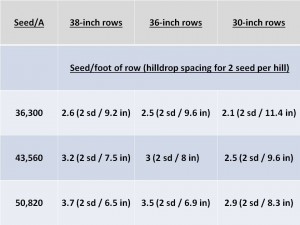Seeding Rate and Plant Population Considerations (Collins & Edmisten)
go.ncsu.edu/readext?404836
en Español / em Português
El inglés es el idioma de control de esta página. En la medida en que haya algún conflicto entre la traducción al inglés y la traducción, el inglés prevalece.
Al hacer clic en el enlace de traducción se activa un servicio de traducción gratuito para convertir la página al español. Al igual que con cualquier traducción por Internet, la conversión no es sensible al contexto y puede que no traduzca el texto en su significado original. NC State Extension no garantiza la exactitud del texto traducido. Por favor, tenga en cuenta que algunas aplicaciones y/o servicios pueden no funcionar como se espera cuando se traducen.
Português
Inglês é o idioma de controle desta página. Na medida que haja algum conflito entre o texto original em Inglês e a tradução, o Inglês prevalece.
Ao clicar no link de tradução, um serviço gratuito de tradução será ativado para converter a página para o Português. Como em qualquer tradução pela internet, a conversão não é sensivel ao contexto e pode não ocorrer a tradução para o significado orginal. O serviço de Extensão da Carolina do Norte (NC State Extension) não garante a exatidão do texto traduzido. Por favor, observe que algumas funções ou serviços podem não funcionar como esperado após a tradução.
English
English is the controlling language of this page. To the extent there is any conflict between the English text and the translation, English controls.
Clicking on the translation link activates a free translation service to convert the page to Spanish. As with any Internet translation, the conversion is not context-sensitive and may not translate the text to its original meaning. NC State Extension does not guarantee the accuracy of the translated text. Please note that some applications and/or services may not function as expected when translated.
Collapse ▲The optimal seeding rate and plant population for cotton varies from field to field and is dependent on many factors. As seed costs are considerable, there is an incentive to reduce seeding rates as low as possible without encountering yield penalties. In recent years, several growers have inquired if plant populations as low as 30,000 plants/A are sufficient for optimal yields. Recent research in Dr. Edmisten’s program has suggested that this plant population may be sufficient if certain conditions are met and if plants are evenly distributed. However it is important to note that:
- Plant populations are not the same as seeding rates. Generally speaking, for 36-inch rows, growers should be planting a minimum seeding rate of around 36,300 seed/A (2.5 seed/foot of row, or 2 seed every 9.6 inches hilldropped) in order to expect a final plant population of 30,000 plants/A.
- 30,000 plants/A should be considered the minimum plant population for achieving optimal yields. The lowest recommended seeding rates mentioned in (1.) above should only be planted when conditions are excellent (i.e., when planting high vigor seed into warm soils with adequate moisture, and when conditions following planting are expected to support good stand establishment). Seeding rates should be adjusted (increased) if planting conditions are less than excellent.
The table below illustrates various seeding rates per acre and the correlating number of seed per foot of row and hill spacing for hilldropping 2 seed for various rows spacings. Note that the lowest recommended “per acre” seeding rate for achieving 30,000 plants per acre is 36,300. Growers should increase seeding rates above that, if any of the following conditions are expected:
- Cool, wet soils: This is most likely to occur when planting in late April or early May and could result in less than optimal plant stands and slow seedling emergence. If soil temperatures in the planting zone are less than 60 to 65ºF by mid morning or if less than 50 DD-60’s are expected within 5 days of planting into moist soils, then seeding rates should be increased. Cotton seed are very sensitive to cool temperatures within the first 2-3 days after planting
- Crusting: growers should consider hilldropping if crusting is expected. Planting high vigor and larger seed could improve stand establishment in these situations
- Poor soil/seed contact or poor seed coverage: cotton should be planted between ½ and ¾ inches deep and planted into warm soils with good moisture. However, less than optimal stands can be expected if the furrow isn’t adequately covered.
- Late planting: Although conditions are generally favorable for rapid seedling emergence during late May, seeding rates may need to be increased in order to avoid late maturity and to avoid reliance on outer position or vegetative bolls as major contributors to the final yield.
Additionally, it is important to realize that all seed are not equal and all planting conditions are not equal. Using cool germination figures and planting conditions to adjust seeding rates can help avoid replanting in some situations. Consider increasing seeding rates when conditions and/or cool germ percentages are marginal. Obtaining cool germination information for each seed lot a grower purchases can also avoid using lower cool germ seed lots in marginal conditions.



